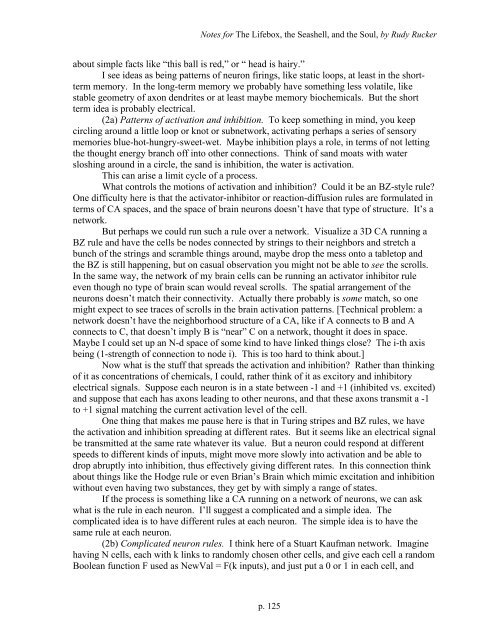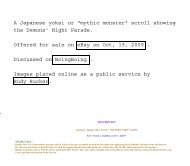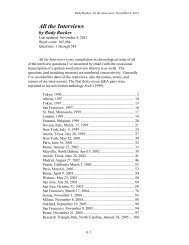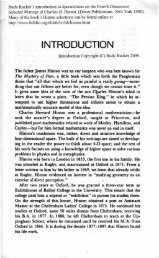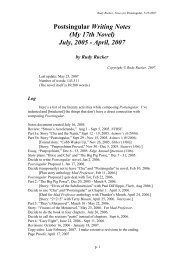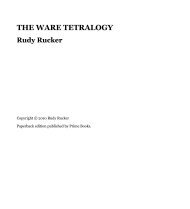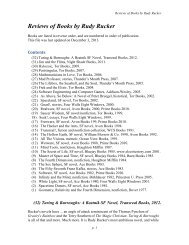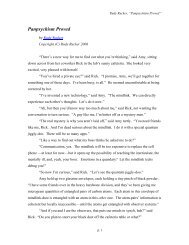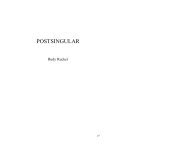Notes for the Lifebox, the Seashell, and the Soul - Rudy Rucker
Notes for the Lifebox, the Seashell, and the Soul - Rudy Rucker
Notes for the Lifebox, the Seashell, and the Soul - Rudy Rucker
You also want an ePaper? Increase the reach of your titles
YUMPU automatically turns print PDFs into web optimized ePapers that Google loves.
<strong>Notes</strong> <strong>for</strong> The <strong>Lifebox</strong>, <strong>the</strong> <strong>Seashell</strong>, <strong>and</strong> <strong>the</strong> <strong>Soul</strong>, by <strong>Rudy</strong> <strong>Rucker</strong><br />
about simple facts like “this ball is red,” or “ head is hairy.”<br />
I see ideas as being patterns of neuron firings, like static loops, at least in <strong>the</strong> shortterm<br />
memory. In <strong>the</strong> long-term memory we probably have something less volatile, like<br />
stable geometry of axon dendrites or at least maybe memory biochemicals. But <strong>the</strong> short<br />
term idea is probably electrical.<br />
(2a) Patterns of activation <strong>and</strong> inhibition. To keep something in mind, you keep<br />
circling around a little loop or knot or subnetwork, activating perhaps a series of sensory<br />
memories blue-hot-hungry-sweet-wet. Maybe inhibition plays a role, in terms of not letting<br />
<strong>the</strong> thought energy branch off into o<strong>the</strong>r connections. Think of s<strong>and</strong> moats with water<br />
sloshing around in a circle, <strong>the</strong> s<strong>and</strong> is inhibition, <strong>the</strong> water is activation.<br />
This can arise a limit cycle of a process.<br />
What controls <strong>the</strong> motions of activation <strong>and</strong> inhibition? Could it be an BZ-style rule?<br />
One difficulty here is that <strong>the</strong> activator-inhibitor or reaction-diffusion rules are <strong>for</strong>mulated in<br />
terms of CA spaces, <strong>and</strong> <strong>the</strong> space of brain neurons doesn’t have that type of structure. It’s a<br />
network.<br />
But perhaps we could run such a rule over a network. Visualize a 3D CA running a<br />
BZ rule <strong>and</strong> have <strong>the</strong> cells be nodes connected by strings to <strong>the</strong>ir neighbors <strong>and</strong> stretch a<br />
bunch of <strong>the</strong> strings <strong>and</strong> scramble things around, maybe drop <strong>the</strong> mess onto a tabletop <strong>and</strong><br />
<strong>the</strong> BZ is still happening, but on casual observation you might not be able to see <strong>the</strong> scrolls.<br />
In <strong>the</strong> same way, <strong>the</strong> network of my brain cells can be running an activator inhibitor rule<br />
even though no type of brain scan would reveal scrolls. The spatial arrangement of <strong>the</strong><br />
neurons doesn’t match <strong>the</strong>ir connectivity. Actually <strong>the</strong>re probably is some match, so one<br />
might expect to see traces of scrolls in <strong>the</strong> brain activation patterns. [Technical problem: a<br />
network doesn’t have <strong>the</strong> neighborhood structure of a CA, like if A connects to B <strong>and</strong> A<br />
connects to C, that doesn’t imply B is “near” C on a network, thought it does in space.<br />
Maybe I could set up an N-d space of some kind to have linked things close? The i-th axis<br />
being (1-strength of connection to node i). This is too hard to think about.]<br />
Now what is <strong>the</strong> stuff that spreads <strong>the</strong> activation <strong>and</strong> inhibition? Ra<strong>the</strong>r than thinking<br />
of it as concentrations of chemicals, I could, ra<strong>the</strong>r think of it as excitory <strong>and</strong> inhibitory<br />
electrical signals. Suppose each neuron is in a state between -1 <strong>and</strong> +1 (inhibited vs. excited)<br />
<strong>and</strong> suppose that each has axons leading to o<strong>the</strong>r neurons, <strong>and</strong> that <strong>the</strong>se axons transmit a -1<br />
to +1 signal matching <strong>the</strong> current activation level of <strong>the</strong> cell.<br />
One thing that makes me pause here is that in Turing stripes <strong>and</strong> BZ rules, we have<br />
<strong>the</strong> activation <strong>and</strong> inhibition spreading at different rates. But it seems like an electrical signal<br />
be transmitted at <strong>the</strong> same rate whatever its value. But a neuron could respond at different<br />
speeds to different kinds of inputs, might move more slowly into activation <strong>and</strong> be able to<br />
drop abruptly into inhibition, thus effectively giving different rates. In this connection think<br />
about things like <strong>the</strong> Hodge rule or even Brian’s Brain which mimic excitation <strong>and</strong> inhibition<br />
without even having two substances, <strong>the</strong>y get by with simply a range of states.<br />
If <strong>the</strong> process is something like a CA running on a network of neurons, we can ask<br />
what is <strong>the</strong> rule in each neuron. I’ll suggest a complicated <strong>and</strong> a simple idea. The<br />
complicated idea is to have different rules at each neuron. The simple idea is to have <strong>the</strong><br />
same rule at each neuron.<br />
(2b) Complicated neuron rules. I think here of a Stuart Kaufman network. Imagine<br />
having N cells, each with k links to r<strong>and</strong>omly chosen o<strong>the</strong>r cells, <strong>and</strong> give each cell a r<strong>and</strong>om<br />
Boolean function F used as NewVal = F(k inputs), <strong>and</strong> just put a 0 or 1 in each cell, <strong>and</strong><br />
p. 125


